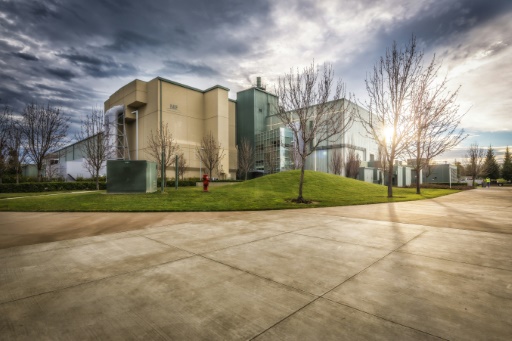U.S. scientists responsible for a historic nuclear fusion breakthrough say they have repeated the feat -- this time achieving a greater yield of energy.
The Lawrence Livermore National Laboratory stunned the world in December when it announced it had carried out an experimental nuclear reaction that put out more energy than was put into it, a holy grail of science in the quest for unlimited, clean power to end the era of fossil fuels.
"We can confirm the experiment produced a higher yield than the December 2022 experiment," public information officer Paul Rhien said Monday in an emailed statement, without disclosing specific figures.
He added the California lab planned to report the results at upcoming scientific conferences and in peer-reviewed publications.
The new development was first reported by the Financial Times.
Nuclear fusion has been touted by its supporters as a clean, abundant and safe source of energy that could eventually allow humanity to break its dependence on coal, crude oil, natural gas and other hydrocarbons driving a global climate crisis.
However, there is still a long way to go before fusion is viable on an industrial scale, providing power to homes and businesses.
Nuclear power plants around the world currently use fission -- the splitting of a heavy atom's nucleus -- to produce energy.
Fusion on the other hand combines two light hydrogen atoms to form one heavier helium atom, releasing a large amount of energy in the process.
That is what occurs inside stars, including our Sun.
On Earth, fusion reactions can be provoked by heating hydrogen to extreme temperatures inside specialized devices.
Like fission, fusion is carbon-free during operation, and has additional critical advantages: it poses no risk of nuclear disaster and produces much less radioactive waste.
During December's experiment, the lab used 192 ultra-powerful lasers to deliver 2.05 megajoules of energy to a tiny capsule smaller than a pea containing isotopes of hydrogen. It produced 3.15 megajoules of fusion energy output.
While the result was a net energy gain, 300 megajoules of energy was needed from the electrical grid to power the lasers.
© 2023 AFP




27 Comments
Kenshin
On a day we remember a mourn the tragic bombing of Nagasaki, we have a seemingly pro nuclear article here. Whether for military use or consumer power, anything nuclear remains a threat the safety of people of all nations.
As a race, we seem to have learned nothing from history.
Joe Blow
Did you even read the article lol
JeffersonLives
Another first for the USA!!!
TaiwanIsNotChina
Fusion will consume pure water one day. As a race, we can't shoot ourselves in the foot out of fear.
TaiwanIsNotChina
Someone's going to have to explain to me how this is a success :/
Strangerland
Because they’ve managed to replicate something that had only been done once, thereby making a proof of concept.
Now it’s just a matter of refining it.
Think of it this way - remember computers that took up entire rooms to do some addition? Now look at your phone.
They just figured out the computer that takes up a room.
Roy Sophveason
The experiment successfully moved the problem of fusion from basic science to engineering.
virusrex
Not learning can be a consequence of just not having the interest of properly inform yourself before making up your mind about something.
The article makes this very clear.
ian
Long way indeed
EFD
This is an excellent analogy. If they can engineer it to production-scale, even the first basic units could make a huge difference.
gcFd1
This article is an opinion piece.
I'll evaluate the issues on my own and make my own conclusions.
Roy Sophveason
Pray tell, what about it is opinion?
GBR48
Nothing requiring [300 megajoules of] energy and infrastructure can be said to be carbon free.
After all the lies about nuclear fission (cheap, clean, safe), we should be honest about nuclear fusion from the start.
theFu
We are still 40+ yrs away from practical uses. I won't be around to see fusion power on the grid, but hopefully by kids and grandkids will.
Fusion for power won't explode. Is that hard to understand?
Now, if the output is beyond all required input point AND the input power is less than 10% of the total power output, then I'll be impressed.
Peter Neil
Some folks need to read the last sentence of the article again.
Strangerland
Someone else needs to read the comments where it has been well addressed.
virusrex
The quoted text is not an opinion but a scientific fact, pretending your personal conclusions can be as valid as the experts on the field is what makes absolutely no sense.
TaiwanIsNotChina
Fission can be all of those things but we went down the light water path to start and no one has been funded to do the molten salt reactors.
Peter Neil
StrangerlandToday 04:34 am JST
“Someone else needs to read the comments where it has been well addressed.”
Sustainable fusion has been forty years away for the last 60 years. The total energy of the system was 302.05 megajoules in for 3.15 megajoules out.
I’ll leave the math to you, if you’re up for it,
Desert Tortoise
Both the US and Soviet navies experimented with sodium cooled reactors, another name for molten salt. Both navies eventually rejected the technology for operational submarines. In the US Navy's case the reactor was removed at the earliest opportunity and replaced with a pressurized water reactor (USS Seawolf), The Soviets hung on to theirs longer and built more boats. The overarching problem is that the if the sodium coolant (molten salt) is allowed to cool it turns into a metallic solid. That means that if you do not have some sort of external heat source and circulate the coolant to keep it molten, it solidifies and your reactor is ruined. The Soviets had such heating systems on the docks their nuclear subs used but they required a lot of maintenance beyond just the maintenance required for the sub. Refueling was much harder to accomplish too. Eventually the Soviets gave up and like the US Navy used only pressurized water reactors.
Roy Sophveason
Correct. But, and that is the breakthrough here, for the first time that is not an issue with the fusion reaction being inefficient, it is an issue with the lasers being inefficient. And again, that is now an engineering problem instead of a scientific one. Can we, for once, cheerfully acknowledge that we are a step closer instead of finding ways to poo-poo every small success?
Strangerland
Again, addressed in the comments already.
Peter Neil
It's still a scientific advancement, nowhere near an engineering one. The lasers were the most powerful on the planet. More powerful lasers will still be for the science. It's not a method for commercialization,
magnetic containment is. Still back to tokamak, which my uncle was associated with in the 1960's and he and I talked about lasers back then.
Sure it's an advancement, but the countdown clock hasn't moved. It's still forty years out like it was 60 years ago.
Strangerland
This article is about how it's a scientific feat.
Strangerland
Some people think we should have had iphones as soon as they figured out computers, and anything less is a failure.
I would say that the venn diagram of these people with those who actually do make progressions for humanity like said scientists, is two perfect side-by-side circles.
albaleo
Sure, but we should also acknowledge the scale of the problem that still remains.
gcFd1
Here you go:
Nuclear fusion has been touted by its supporters as a clean, abundant and safe source of energy that could eventually allow humanity to break its dependence on coal, crude oil, natural gas and other hydrocarbons driving a global climate crisis.